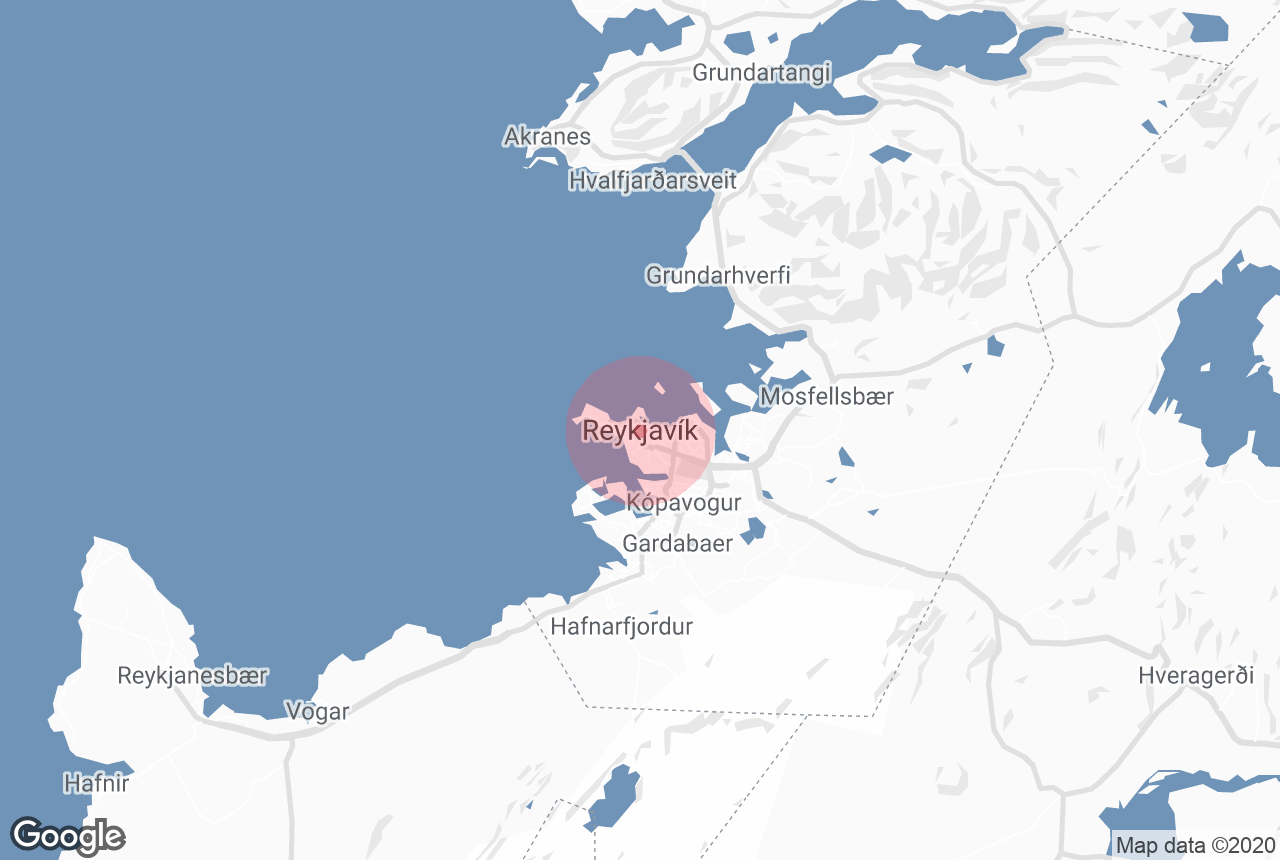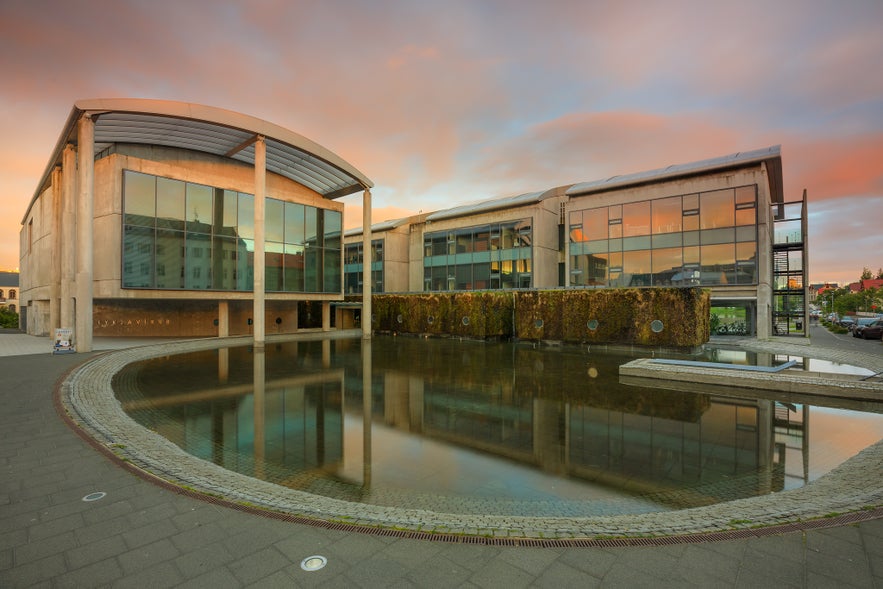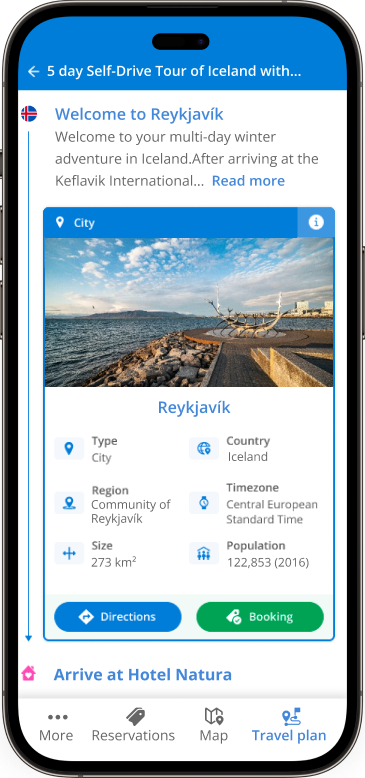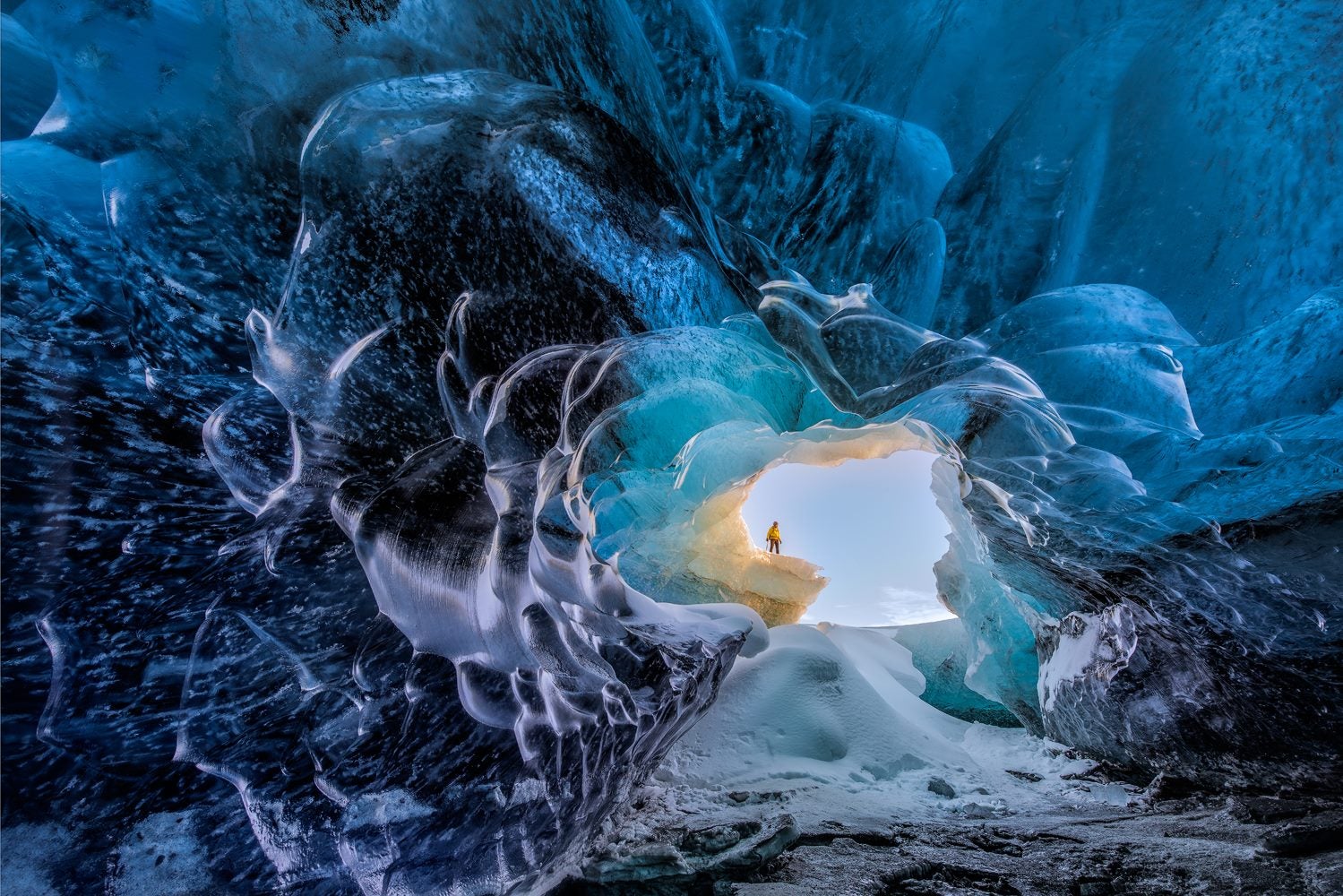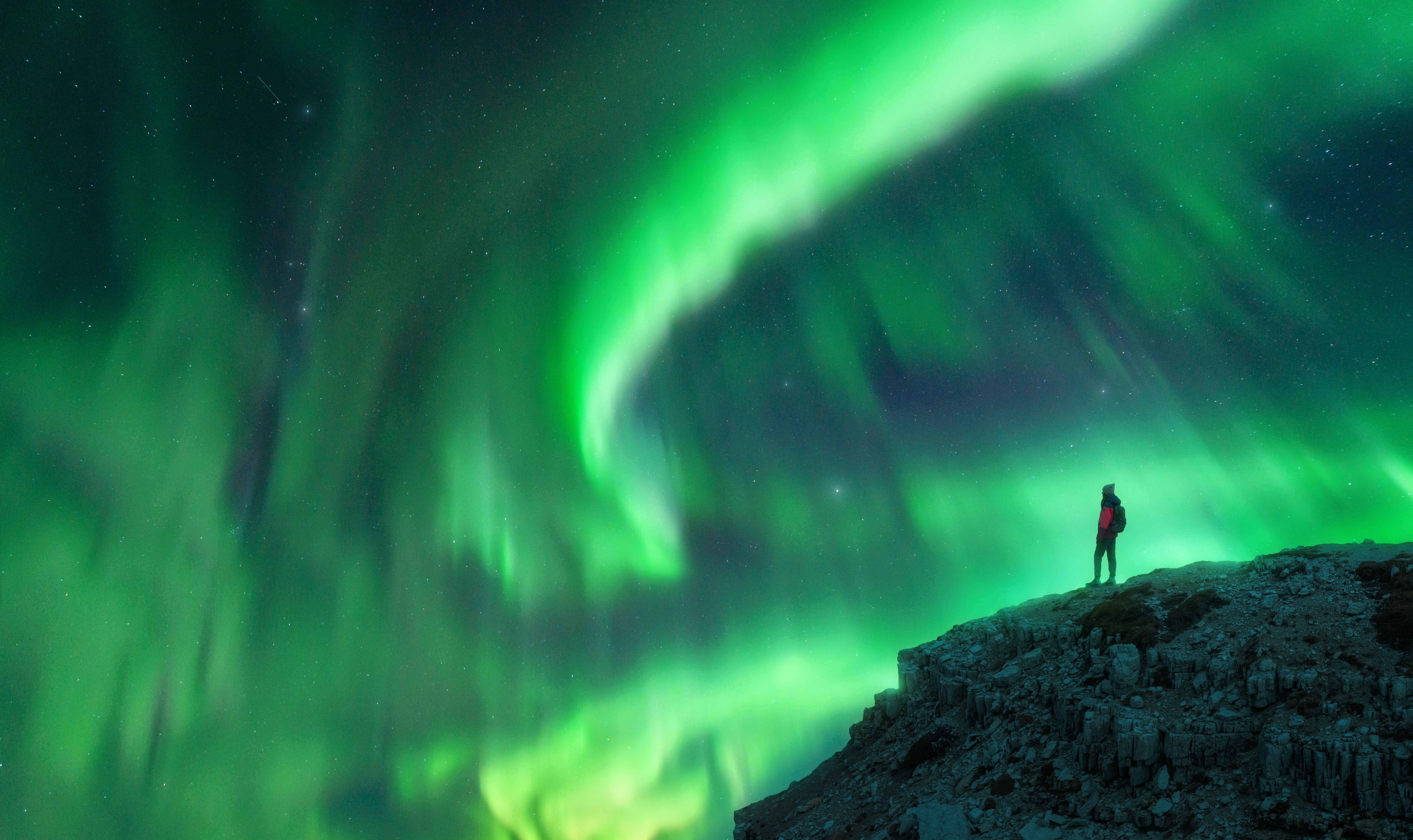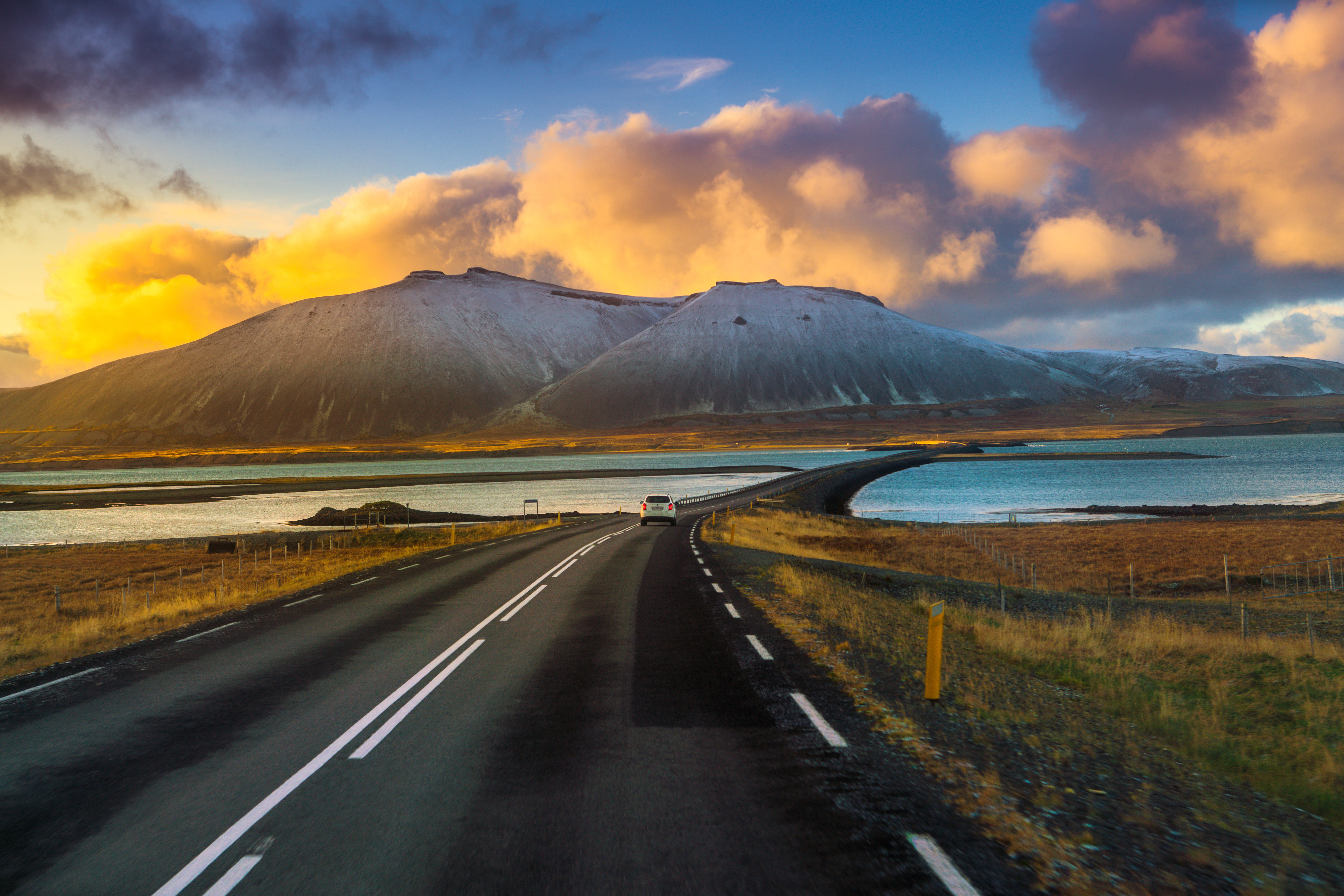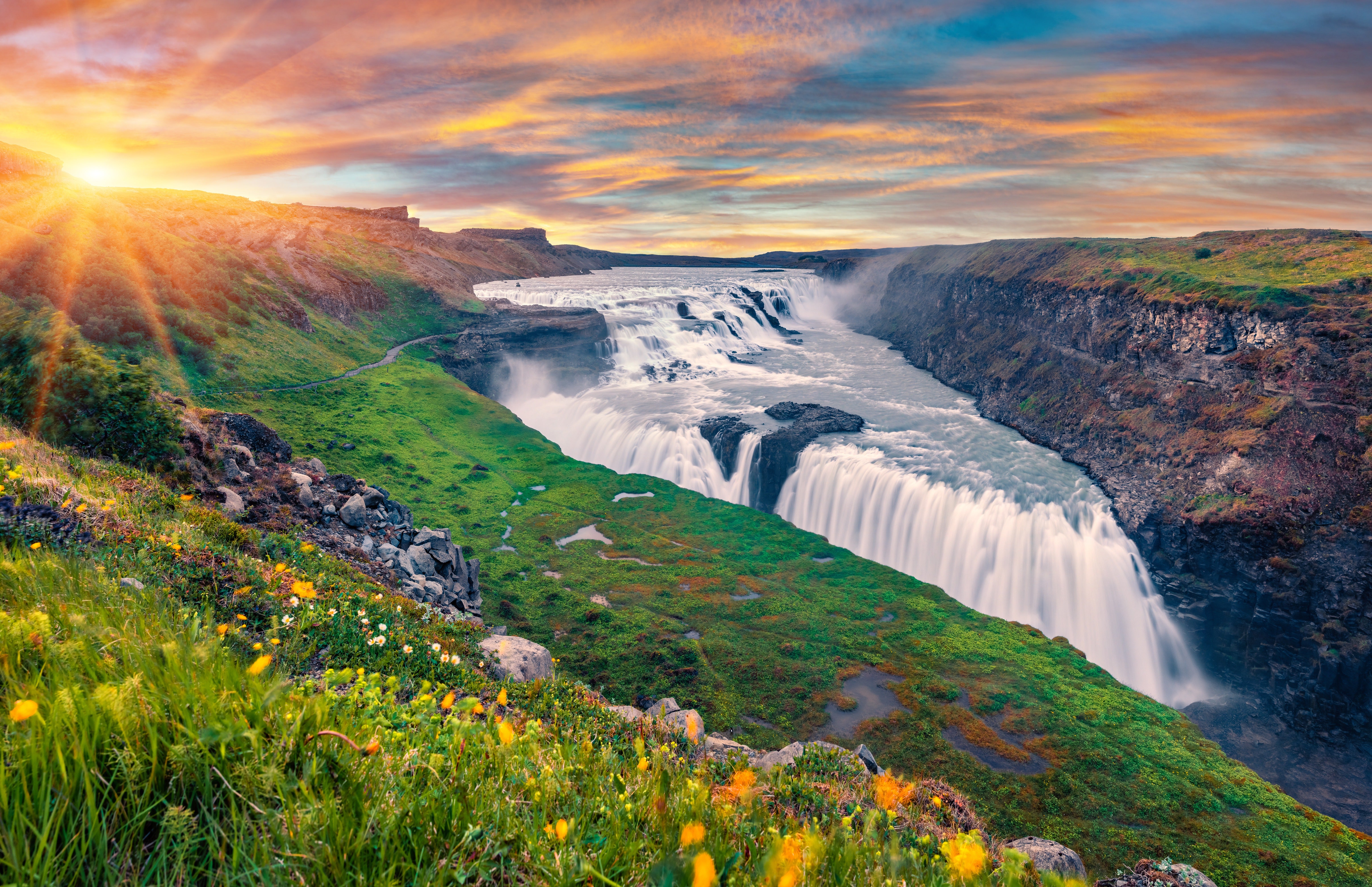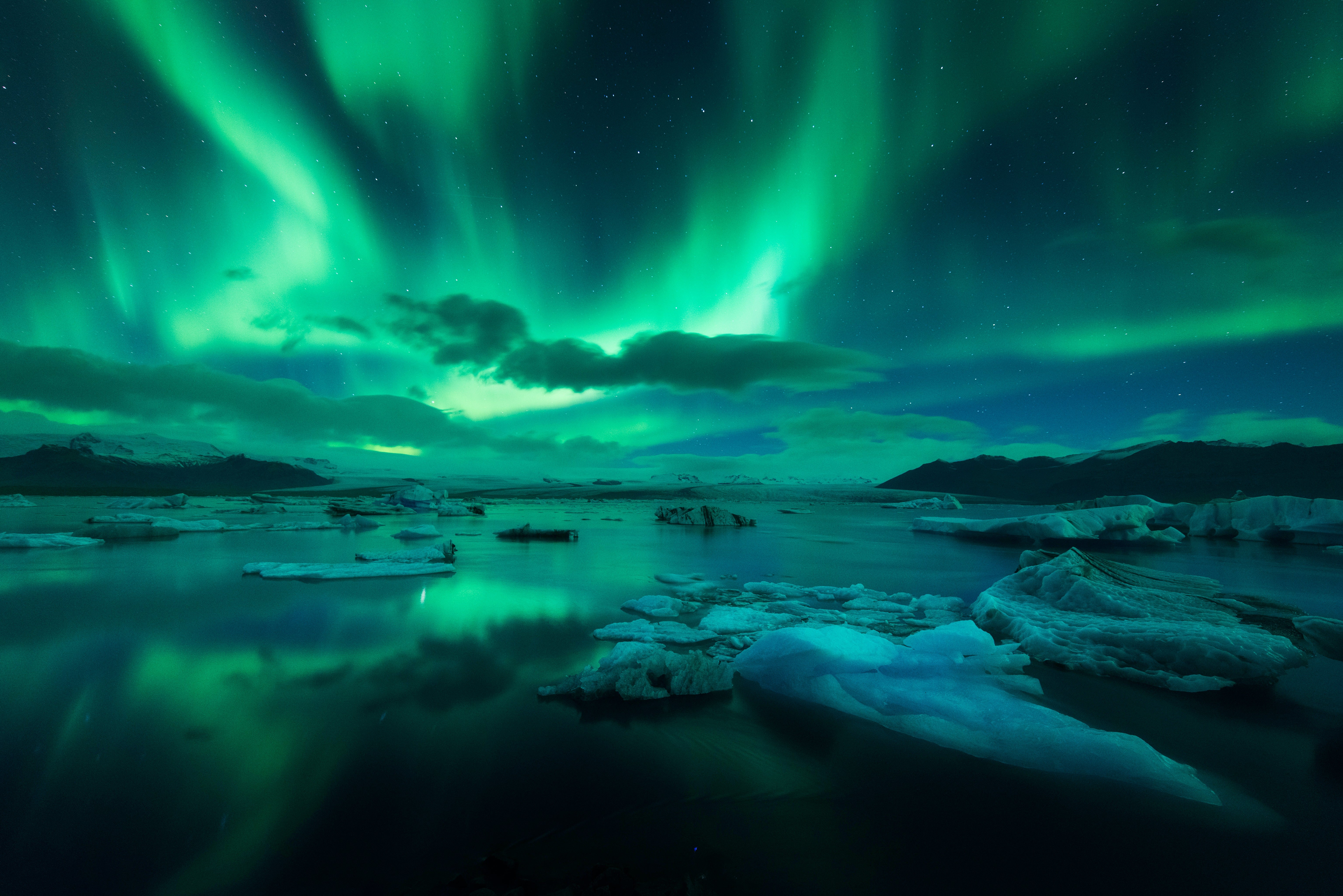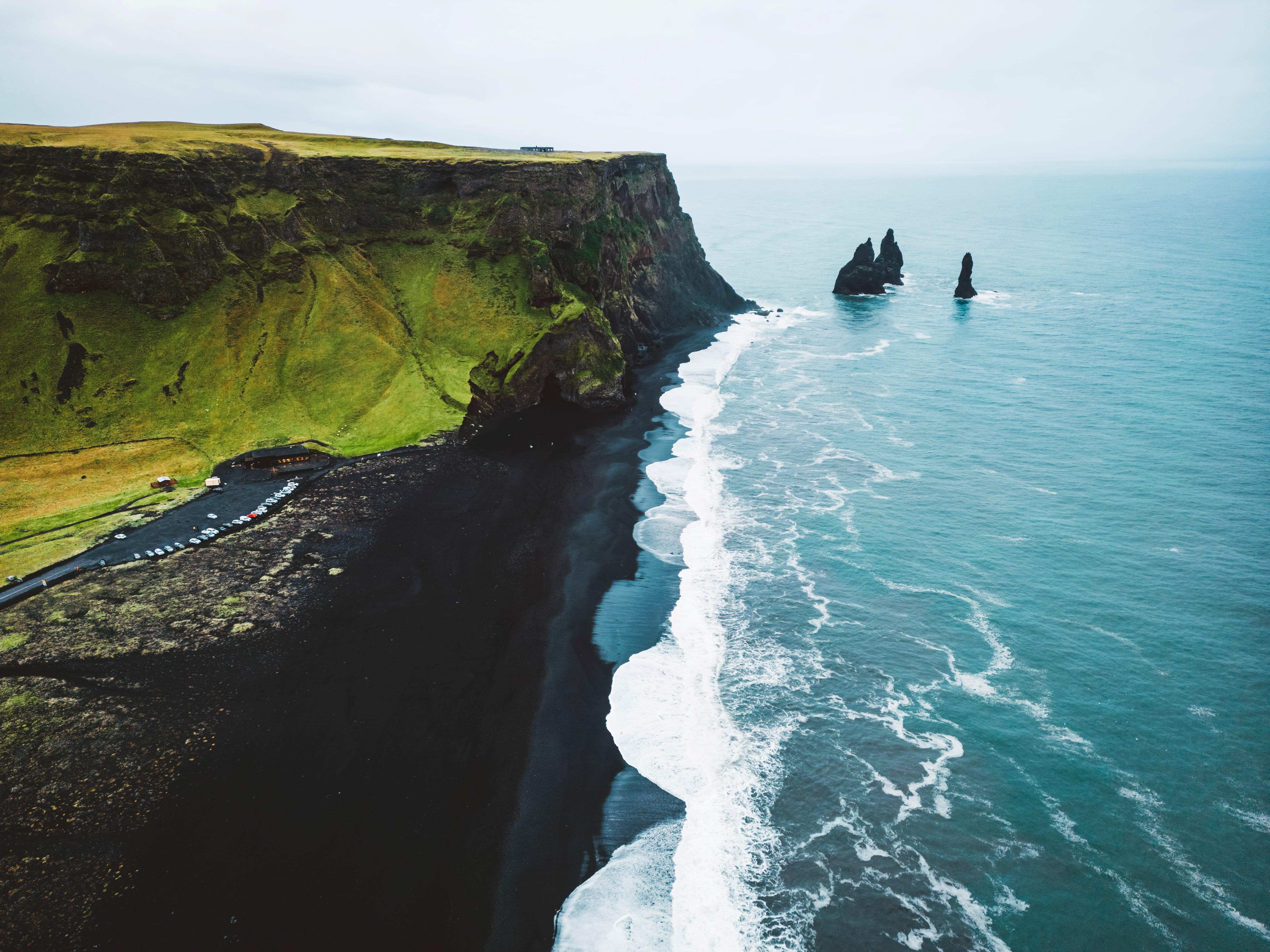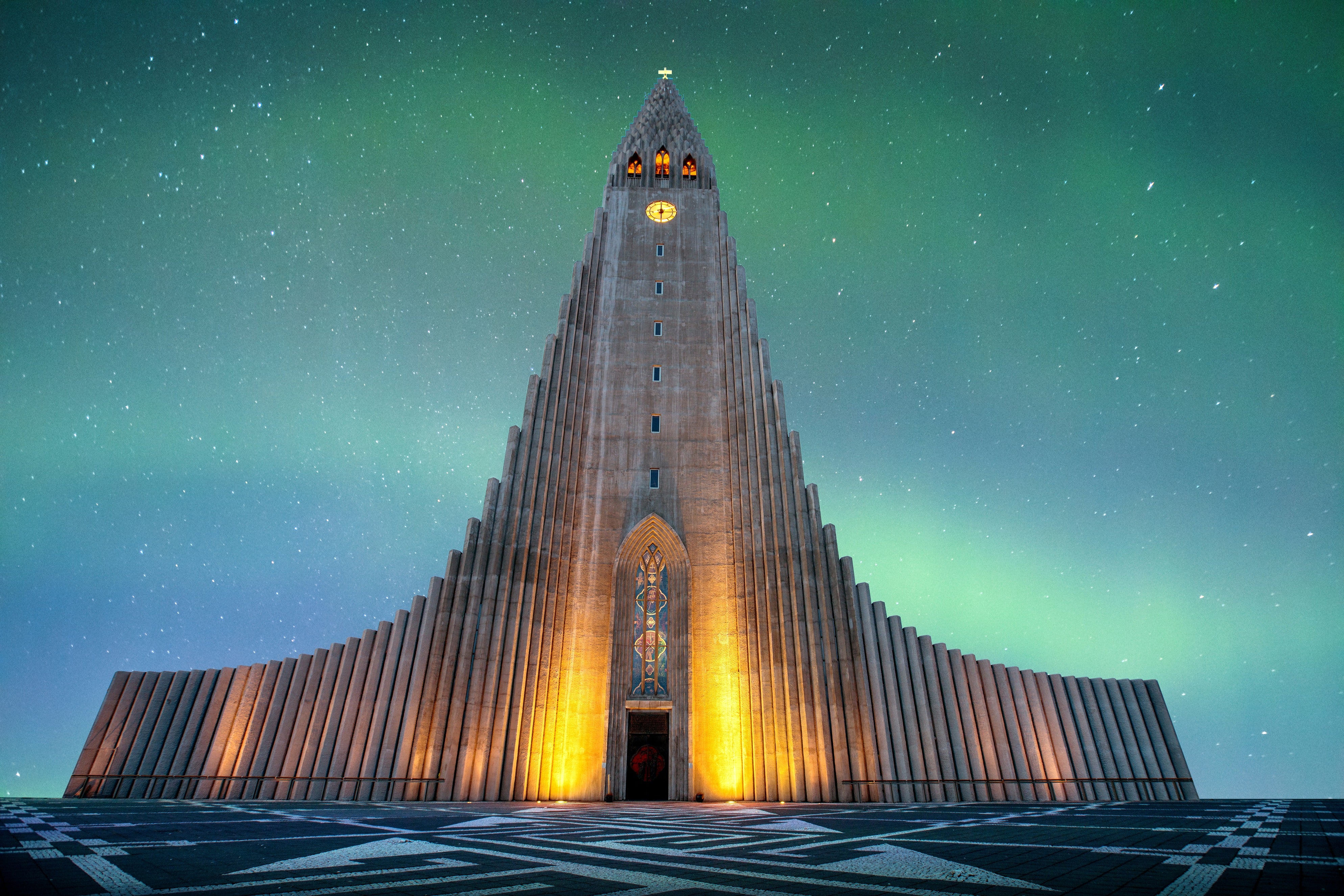Bold, modern, and seemingly floating on the edge of Reykjavik’s Tjornin Pond (Tjörnin), Reykjavik City Hall (Ráðhúsið) is where striking architecture meets cultural depth. Inside, visitors can explore a massive 3D relief map of Iceland, browse exhibitions, and enjoy the building’s unique connection to water, wildlife, and civic life.
This glass-and-concrete landmark serves as the headquarters for the city’s mayor and council, but it also doubles as a vibrant public space. From live music performances and art exhibitions in Tjarnarsalur Hall to photography displays and architectural models, it blends civic function with creativity.
Why You Can Trust Our Content
Guide to Iceland is the most trusted travel platform in Iceland, helping millions of visitors each year. All our content is written and reviewed by local experts who are deeply familiar with Iceland. You can count on us for accurate, up-to-date, and trustworthy travel advice.
The building is deliberately designed to invite nature into the urban core. Walkways stretch over the pond, birds gather along the shoreline, and calming panoramic views of Tjornin complete the peaceful setting.
Conveniently located in downtown Reykjavik, this City Hall is open to the public and easy to reach on foot. Whether you're planning to stop in for a quick look at the iconic 3D map or take a quiet break by the pond, it offers a peaceful and visually striking escape just minutes from Reykjavik’s main attractions.
Key Takeaways
-
Architectural Landmark in the City Center: With its modern concrete-and-glass design extending over Tjornin Pond, Reykjavik City Hall stands out as one of the capital’s most striking civic buildings.
-
Home to the Giant 3D Map of Iceland: The detailed relief map in the lobby offers a unique, bird’s-eye view of the entire country, ideal for orientation and trip planning.
-
Cultural and Civic Hub: Hosts rotating art exhibitions, live events, and photography displays in spaces like Tjarnarsalur, while also housing the offices of the mayor and city council.
-
One-Stop Travel Resource: The Guide to Iceland information desk inside Reykjavik City Hall provides expert local tips, tour bookings, car rentals, Reykjavik City Cards, and everything else you need to plan your Iceland trip.
-
Free and Easy to Visit: Centrally located and open to the public, it’s a peaceful stop for visitors exploring downtown Reykjavik on foot.
Architectural Features of Reykjavik City Hall

Reykjavik City Hall is a striking example of how architecture can bridge the urban and the natural. Completed in 1992, the building appears to float on the edge of Tjornin Pond, blending raw Icelandic materials with modern Nordic design.
It’s surrounded by walkways over water, moss-covered walls, and green vertical gardens. It serves not only as a functional civic space but also as one of Reykjavik’s most photogenic and symbolic structures.
The hall was born from an international design competition held in 1986, which attracted 38 submissions. The winning proposal came from two young Reykjavik-based architects—Margret Hardardottir (Margrét Harðardóttir) and Steve Christer of Studio Granda—graduates of the London Architectural Association.
Their concept envisioned the city hall as an “interface” where Reykjavik’s built environment could interact with its natural surroundings in a seamless, three-dimensional whole.
The building is made up of two connected sections that serve different roles, with several important areas inside:
-
The Council Building – Located on Vonarstraeti (Vonarstræti), it houses the City Council chambers and executive meeting rooms. Its massive, geometric structure reflects the manmade order of Reykjavik’s Kvos district, with elliptical skylights that let natural light filter in from above.
-
The Office Building – Positioned along the pond, it includes the offices of the mayor and city officials. Large south-facing windows and a glass wall make it feel bright and open.
-
Tjarnarsalur Hall – The main public space on the ground floor, used for art exhibitions, cultural events, and public receptions.
-
The Lake Room – Another event and exhibition space, offers sweeping views over Tjornin Pond. Often used for seasonal displays, press events, and cultural shows. It’s also where the giant 3D relief map of Iceland is displayed.
 Just outside, a small manmade pond sits at the corner of Tjarnargata and Vonarstraeti. Next to it is a moss-covered wall, inspired by Iceland’s lava landscapes, which helps connect the building to nature.
Just outside, a small manmade pond sits at the corner of Tjarnargata and Vonarstraeti. Next to it is a moss-covered wall, inspired by Iceland’s lava landscapes, which helps connect the building to nature.
The materials were chosen carefully—light-colored concrete keeps the building bright in all weather, and the mix of stone, water, and plants adds to its calm, welcoming atmosphere.
Just behind the building, a wide footpath runs along the edge of Tjornin Pond. In winter, geothermal water is pumped into the area to prevent it from fully freezing. This not only adds a touch of warmth to the urban landscape but also creates a safe space for ducks and other Icelandic birdlife year-round.
Reykjavik City Hall is also part of the city's larger administrative network, which includes other key office buildings such as Hofdi House (Höfði). The office facilities at Tjarnargata 12 and Hofdatorg Business Center (Höfðatorg) on Borgartun (Borgartún) are also part of it.
History of Reykjavik City Hall
 The idea of building a city hall in Reykjavik dates back more than two centuries. Still, it took generations of proposals, planning attempts, and public discussions before the project was finally realized.
The idea of building a city hall in Reykjavik dates back more than two centuries. Still, it took generations of proposals, planning attempts, and public discussions before the project was finally realized.
The northern shore of Tjornin Pond was eventually chosen as the site. Thanks to its natural beauty and central location, it was seen as a fitting setting for a building meant to represent Iceland’s capital.
Quick Trivia: Reykjavik first started discussing the idea of a city hall in 1799, but it wasn’t built until 1992—nearly 200 years later!
Here’s how the timeline of building the Reykjavik City Hall unfolded:
-
1799 – The idea of building a city hall in Reykjavik was first mentioned in a letter from the Chancellery in Copenhagen to the regional governor of Iceland, just 13 years after Reykjavik received municipal rights.
-
1835 – Nationalist leader Tomas Saemundsson (Tómas Sæmundsson) wrote about the need for a city hall in the journal Fjolnir (Fjölnir).
-
1918 – Mayor Knud Zimsen formed the first official committee to explore building a city hall.
-
1929 – Council offices were moved to Austurstraeti 16; funds were approved for a new hall, but the project was never carried out.
-
1941–1955 – Several committees were formed, and various sites were proposed. The northern shore of Tjornin emerged as the preferred location.
-
1962–1964 – The city’s general plan included a city hall at the lake, and design proposals were displayed publicly, but the project was again postponed.
-
1984 – Mayor David Oddsson (Davíð Oddsson) revived the idea with a proposal to build at Tjarnargata 11, by the northwestern corner of the lake.
-
1986 – An open design competition was launched, receiving 38 entries.
-
1987 – Architects Margret Hardardottir and Steve Christer of Studio Granda won the competition and were commissioned to lead the project.
-
1988 – Groundbreaking took place on April 14, led by Mayor David Oddsson. The foundation stone was laid on August 18, during Reykjavik Day.
-
1990 – The building’s outer structure was completed in spring. Interior work and landscaping began.
-
1991 – The ceremonial cornerstone was placed on April 28.
-
1992 – Reykjavik City Hall was officially inaugurated on April 14, with Mayor Markus Orn Antonsson (Markús Örn Antonsson) presiding over the opening.
After nearly two centuries of starts and stops, Reykjavik City Hall now stands as a lasting symbol of civic vision and architectural ambition. It finally brings a long-held dream to life on the edge of Tjornin Pond.
Where Is Reykjavik City Hall Located
 Reykjavik City Hall sits on the northern bank of Tjornin Pond, right in the heart of the city’s historic center. Its address is Tjarnargata 11, 101 Reykjavik, and it occupies one of the most scenic and symbolic locations in the capital.
Reykjavik City Hall sits on the northern bank of Tjornin Pond, right in the heart of the city’s historic center. Its address is Tjarnargata 11, 101 Reykjavik, and it occupies one of the most scenic and symbolic locations in the capital.
City planners chose this site carefully. Not just for its convenience but also because the area has long been seen as the heart of Reykjavik’s Old Town.
For travelers, the location is as practical as it is beautiful.
Reykjavik City Hall is the designated Bus Stop #1, a central pickup and drop-off point for day tours and walking tours. It’s just a short walk from Iceland's key landmarks like Parliament House (Alþingi) and Austurvollur Square (Austurvöllur), making it easy to include in any downtown itinerary.
Things To Do at Reykjavik City Hall
 While Reykjavik City Hall serves an important political role, its ground floor is designed with visitors in mind. It’s a public space where locals and travelers can relax by the pond, admire views of Tjornin Pond, explore cultural exhibits, or simply enjoy the calm atmosphere.
While Reykjavik City Hall serves an important political role, its ground floor is designed with visitors in mind. It’s a public space where locals and travelers can relax by the pond, admire views of Tjornin Pond, explore cultural exhibits, or simply enjoy the calm atmosphere.
Whether you're stopping in for five minutes or staying longer, here’s what you can see and do inside the Reykjavik City Hall.
Check Out the Giant 3D Map of Iceland
 One of the most popular attractions inside Reykjavik City Hall is the giant 3D relief map of Iceland. It’s a massive topographical model that gives visitors a full, elevated view of the entire country. Covering 822 square feet (76.4 square meters), it’s detailed enough to visually trace Iceland’s many volcanoes, glaciers, fjords, and mountain ranges.
One of the most popular attractions inside Reykjavik City Hall is the giant 3D relief map of Iceland. It’s a massive topographical model that gives visitors a full, elevated view of the entire country. Covering 822 square feet (76.4 square meters), it’s detailed enough to visually trace Iceland’s many volcanoes, glaciers, fjords, and mountain ranges.
Work on the model began in 1985, originally to represent just the first settlements of Ingolfur Arnarson (Ingólfur Arnarson), one of the most famous Icelanders in history. However, the vision quickly expanded, and by the time Reykjavik City Hall opened in 1992, the finished model depicted all of Iceland, complete with surrounding seas.
It was installed in the Lake Room, where it remains on display today. To accommodate events, the model was built on a rolling platform that can be smoothly moved into a hidden storage space when needed.
The Scale of the 3D Relief Map of Iceland at Reykjavik City Hall
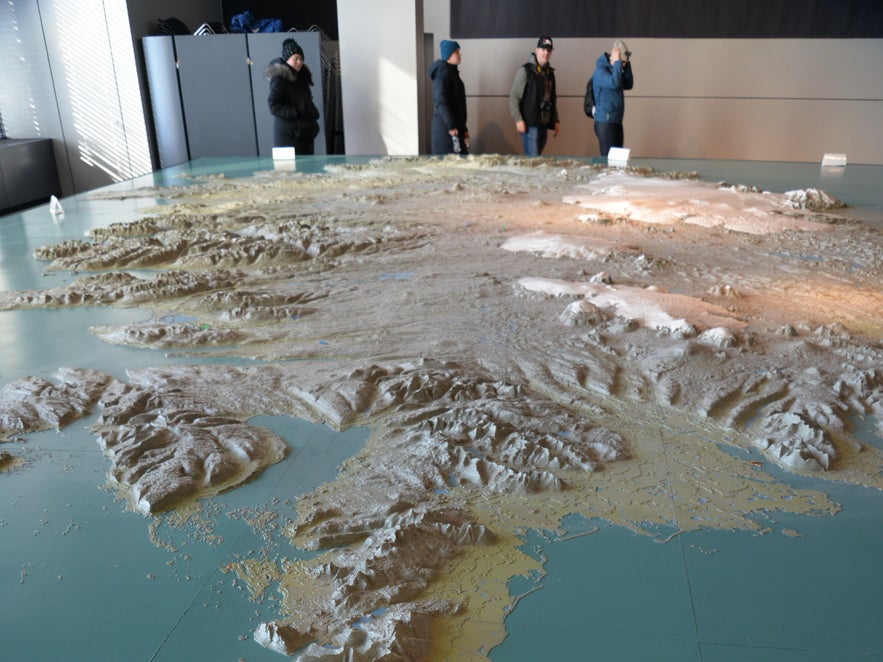 The model was built by four skilled craftsmen. Those are Axel Helgason, Arni Hreidar Arnason (Árni Hreiðar Árnason), Jonas Magnusson (Jónas Magnússon), and Kristjan Sigurdsson (Kristján Sigurðsson) at Reykjavik’s Model Workshop. Sigurdur Palsson (Sigurður Pálsson) also contributed as the painter.
The model was built by four skilled craftsmen. Those are Axel Helgason, Arni Hreidar Arnason (Árni Hreiðar Árnason), Jonas Magnusson (Jónas Magnússon), and Kristjan Sigurdsson (Kristján Sigurðsson) at Reykjavik’s Model Workshop. Sigurdur Palsson (Sigurður Pálsson) also contributed as the painter.
It’s made from 0.04-inch (1-millimeter) thick cardboard, cut layer by layer along contour lines to show Iceland’s terrain. Each layer represents 66 feet (20 meters) of elevation, with 106 layers stacked from sea level to the peak of Oraefajokull Volcano (Öræfajökull). These layers were glued and mounted onto wooden plates, which were then fixed to a sturdy aluminum frame.
The entire model is divided into 57 sections—43 of land and 14 of surrounding sea. Each section averages 14.5 square feet (1.35 square meters) and covers about 1,160 square miles (3,000 square kilometers) of actual land.
The vertical scale is 1:25,000, double the base map scale of 1:50,000. This map is based on the aerial map service series C762 created by the U.S. Army in 1945 and 1946.
What began as a temporary piece for a technology exhibition at the Reykjavik City Theatre during the city’s 200th anniversary in 1986 has become a lasting favorite. Today, it’s recognized as a remarkable tool for understanding Iceland’s geography before setting off on your own journey.
See Art Exhibits and Communal Events
 If you're visiting Reykjavik City Hall, don’t miss the chance to step inside Tjarnarsalur Hall, a spacious venue known as the People’s Hall. Located on the ground floor, it regularly hosts art exhibitions, concerts, public talks, conferences, and community events like the Crafts and Design Fair.
If you're visiting Reykjavik City Hall, don’t miss the chance to step inside Tjarnarsalur Hall, a spacious venue known as the People’s Hall. Located on the ground floor, it regularly hosts art exhibitions, concerts, public talks, conferences, and community events like the Crafts and Design Fair.
Note: It’s also available to rent for private functions. If you’re planning something special in Reykjavik, you can easily apply through the city’s website.
Right next to it is the Lake Room, the largest event space in Reykjavik City Hall and home to the giant 3D relief map of Iceland. Bright and modern, it offers beautiful views of Tjornin Pond and regularly hosts exhibitions and seasonal displays. Unless an event is underway, you’re welcome to walk through the space and enjoy the architecture and exhibits at your own pace.
Relax by Tjornin City Pond
 Step outside Reykjavik City Hall and you’ll find yourself beside Tjornin, a peaceful city pond that feels like a quiet oasis right in the center of downtown. Locals and travelers alike come here to unwind. Whether it’s to sit on the benches and watch the ducks, swans, and geese glide by, or to stroll along the scenic paths that circle the water.
Step outside Reykjavik City Hall and you’ll find yourself beside Tjornin, a peaceful city pond that feels like a quiet oasis right in the center of downtown. Locals and travelers alike come here to unwind. Whether it’s to sit on the benches and watch the ducks, swans, and geese glide by, or to stroll along the scenic paths that circle the water.
On warmer days, the pond is alive with birdlife and reflections of nearby historic houses. Especially along Tjarnargata Street, where some of Reykjavik’s best-preserved homes still stand. There’s a wide boardwalk, plenty of seating, and beautiful views of the city’s rooftops and church spires, making visiting Reykjavik City Hall one of the relaxing things to do in Reykjavik.
In winter, Tjornin Pond freezes over, creating a quiet, snow-covered landscape that’s just as inviting. A small heated area in front of Reykjavik City Hall stays thawed to keep space for the waterfowl, so you’ll still spot ducks, geese, swans, and gulls paddling peacefully. When conditions are right, parts of the frozen pond are even used by locals for skating or crossing on foot.
Get Local Tips at the Reykjavik Visitor Info Center
 Whether you’re just getting started with your Iceland adventure or need help fine-tuning your travel plans, the visitor information center inside Reykjavik City Hall is the perfect place to stop. Located right on the ground floor, it’s run in partnership with Guide to Iceland, Iceland’s leading travel platform, and offers free access to expert advice, maps, brochures, and digital tools.
Whether you’re just getting started with your Iceland adventure or need help fine-tuning your travel plans, the visitor information center inside Reykjavik City Hall is the perfect place to stop. Located right on the ground floor, it’s run in partnership with Guide to Iceland, Iceland’s leading travel platform, and offers free access to expert advice, maps, brochures, and digital tools.
You can walk in at any time during opening hours to:
-
Book guided tours around Reykjavik or across Iceland
-
Arrange accommodations or rental cars
-
Plan your travel routes and day trips
-
Buy the Reykjavik City Card for free museum entry and transport perks
-
Pick up brochures, maps, and local guides to help plan your journey
Beyond travel services, the space is designed as a public zone that blends seamlessly with the foot traffic of the city. The center also features regular art exhibitions by local artists, restrooms (free to use), charging stations, phone lockers, and internet access—all in a clean and welcoming setting.
Thanks to its central location and open design, the ground floor of Reykjavik City Hall feels like an extension of the street. It’s an accessible hub where culture, civic life, and travel support meet.
How To Get to Reykjavik City Hall
 Reykjavik City Hall is centrally located and easy to reach on foot, by car, by public transport, or as part of a guided tour. Whether you're exploring the city on your own or joining an organized excursion, this landmark is one of the most accessible spots in Reykjavik. Just minutes from the city’s top attractions and transport hubs.
Reykjavik City Hall is centrally located and easy to reach on foot, by car, by public transport, or as part of a guided tour. Whether you're exploring the city on your own or joining an organized excursion, this landmark is one of the most accessible spots in Reykjavik. Just minutes from the city’s top attractions and transport hubs.
On Foot
 Reykjavik City Hall is one of the easiest places to reach on foot when exploring the city center. It’s located just a few minutes’ walk from Austurvollur Square, Parliament House, and many popular cafes, shops, and museums.
Reykjavik City Hall is one of the easiest places to reach on foot when exploring the city center. It’s located just a few minutes’ walk from Austurvollur Square, Parliament House, and many popular cafes, shops, and museums.
You can access the building directly from Tjarnargata Street. Or take the scenic route via a pedestrian bridge over Tjornin Pond, where ducks and swans often gather near the walkway.
The building is also a natural stop along several walking routes through Reykjavik’s Old Town, acting almost like an extension of the street itself. As you pass through the ground floor, large windows, public art, and cultural displays invite you to pause, explore, and learn more about the city and its hidden gems.
For a guided experience, join one of these walking tours that includes a stop at Reykjavik City Hall:
-
Enriching Reykjavik walking tour – A cultural and historical tour visiting sites like Hallgrimskirkja, Einar Jonsson Sculpture Garden, Reykjavik Old Harbor, and more.
-
Private walking tour of Reykjavik's history – A customizable 2-hour private tour tailored to your interests, offering insights into Reykjavik's landmarks and history with a personal guide.
-
Walking tour of Reykjavik’s history and culture – A 2.5-hour small-group tour covering Reykjavik's history, architecture, and culture, including stops at Hallgrimskirkja, Harpa Concert Hall, and the Parliament House.
-
Viking walking tour of Reykjavik – Join a knowledgeable Viking guide on this 2-hour tour, exploring Reykjavik's main attractions and hidden gems while learning about Icelandic history and folklore.
-
Icelandic women’s history walking tour in Reykjavik – A 3-hour tour focused on the role of women in Icelandic society, visiting sites linked to women empowerment and political history, including Reykjavik City Hall.
-
Folklore walking tour of Reykjavik – Explore Reykjavik's rich mythology by delving into tales of elves, trolls, and hidden people on this 1.5-hour guided tour.
By Car
 Reykjavik City Hall is easily accessible by car and makes a convenient stop if you’re driving around the capital or starting a self-drive tour of Iceland. Located in the heart of downtown, the building is situated along Tjarnargata Street, right next to Tjornin Pond.
Reykjavik City Hall is easily accessible by car and makes a convenient stop if you’re driving around the capital or starting a self-drive tour of Iceland. Located in the heart of downtown, the building is situated along Tjarnargata Street, right next to Tjornin Pond.
There’s metered street parking available near the building and along surrounding streets like Vonarstraeti and Skothusvegur (Skothúsvegur). You’ll also find nearby public parking garages within walking distance.
Note: Keep in mind that parking in central Reykjavik can be limited during peak hours, so it’s a good idea to arrive early or plan ahead.
Reykjavik City Hall is a practical starting point for many self-drive travelers. You can stop in to pick up maps, get itinerary advice, or book last-minute tours and services through the on-site Guide to Iceland information desk.
With its central location and easy access to major roads, it's a great place to base yourself before hitting the Ring Road or exploring the Golden Circle.
Tip: For maximum comfort and flexibility, consider renting a car in Reykjavik. Also, don’t forget to check out our ultimate guide to driving in Iceland before you hit the road.
By Public Transportation
 Reykjavik City Hall is well-connected by public transport in Iceland, making it easy to reach without a car. The building is located right next to Bus Stop #1 – Reykjavik City Hall (Ráðhúsið), one of the main pickup and drop-off points for both local buses and popular guided tours.
Reykjavik City Hall is well-connected by public transport in Iceland, making it easy to reach without a car. The building is located right next to Bus Stop #1 – Reykjavik City Hall (Ráðhúsið), one of the main pickup and drop-off points for both local buses and popular guided tours.
If you're using Straeto (Strætó), Reykjavik’s public bus system, several routes stop within a short walk of Reykjavik City Hall. From the Hlemmur bus terminal or other parts of the city, you can take buses that drop you off near Laekjargata Street (Lækjargata) or Austurvollur Square, and walk just a few minutes to the pond.
The location is especially convenient if you're combining independent travel with day tours or vacation packages in Iceland, as many tour operators use Bus Stop #1 as a central meeting point.
Once you arrive, you'll find everything you need inside—Icelandic maps, local tips, travel services, and restrooms—all just steps from the bus stop.
By Guided Tours
 Reykjavik City Hall is a common stop, or even starting point, for many guided tours in the city. If you're joining a walking tour of Reykjavik, chances are you'll either begin or end your journey here, thanks to its central location and cultural significance.
Reykjavik City Hall is a common stop, or even starting point, for many guided tours in the city. If you're joining a walking tour of Reykjavik, chances are you'll either begin or end your journey here, thanks to its central location and cultural significance.
The building is also available for pre-arranged guided visits, typically offered Monday to Thursday between 10:00 and 15:00, lasting around 30 minutes. These visits can include insights into the building’s architecture, exhibitions, and civic functions, depending on availability and request.
Note: For guided visits, book through Reykjavik’s official website.
If you're planning your trip, here are some recommended private tours and multi-day tours in Iceland that include a stop at Reykjavik City Hall:
-
Private sightseeing tour of Reykjavik and the Blue Lagoon – Explore Reykjavik's cultural and historical landmarks, including Hallgrimskirkja and Harpa Concert Hall. Followed by a relaxing soak in the Blue Lagoon.
-
6-day adventure tour of South Iceland & Reykjavik – Embark on a comprehensive journey through Iceland's South Coast, visiting waterfalls, black sand beaches, and glaciers, with additional time to explore Reykjavik's lively city life.
-
Christmas and Northern Lights 6-day festive adventure tour in Iceland – Celebrate Christmas in Iceland with this festive tour that combines traditional holiday experiences with visits to natural wonders and opportunities to witness the northern lights.
Best Time To Visit Reykjavik City Hall
 Reykjavik City Hall is open year-round, making it an easy addition to any itinerary, no matter the season. Since most of its highlights are indoors, like the 3D relief map and rotating exhibitions, it’s an ideal stop on rainy days or during the colder months.
Reykjavik City Hall is open year-round, making it an easy addition to any itinerary, no matter the season. Since most of its highlights are indoors, like the 3D relief map and rotating exhibitions, it’s an ideal stop on rainy days or during the colder months.
In winter, the adjacent Tjornin Pond often freezes over, creating a peaceful, snow-dusted scene where locals sometimes skate or walk across the ice. A small section near the building is kept warm with geothermal water, so you’ll still see ducks and swans paddling nearby.
In spring, summer, and early autumn, the area becomes even more scenic. You can find open walkways, benches by the water, and the sound of birds filling the air. It’s perfect for a relaxing pause while sightseeing around Reykjavik.
It’s also a convenient stop during the day, especially if you're already in the city center or joining a tour that departs from nearby Bus Stop #1. For a quieter visit, consider stopping by on weekday mornings.
Opening Hours:
-
Weekdays: 08:00–18:00
-
Saturdays: 10:00–18:00
-
Sundays: 12:00–18:00
Whether you’re getting out of the weather or enjoying the quiet views, Reykjavik City Hall is a calm and useful place to stop right in the center of the city.
Attractions Near Reykjavik City Hall
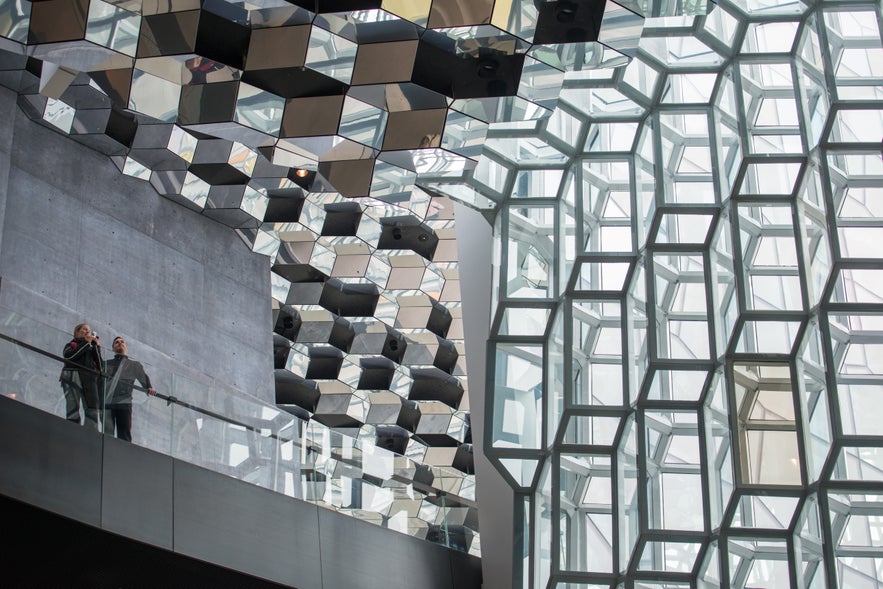 Thanks to its central location, Reykjavik City Hall is surrounded by many of the city’s most popular cultural, historical, and architectural attractions. Whether you’re visiting on foot or building a larger Reykjavik itinerary, here are some must-see places within easy reach:
Thanks to its central location, Reykjavik City Hall is surrounded by many of the city’s most popular cultural, historical, and architectural attractions. Whether you’re visiting on foot or building a larger Reykjavik itinerary, here are some must-see places within easy reach:
-
Austurvollur Square – A historic gathering place surrounded by restaurants, Parliament House, and Domkirkjan (the city’s cathedral).
-
Hallgrimskirkja Church (Hallgrímskirkja) – Reykjavik’s iconic church with panoramic city views.
-
The Settlement Exhibition – A fascinating look at early Viking life with real archaeological remains beneath the city.
-
Harpa Concert Hall – A stunning modern building by the waterfront, home to concerts, exhibits, and fantastic photo ops.
-
Sun Voyager Sculpture – A striking steel sculpture on the seaside path, symbolizing dreams of exploration.
-
National Museum of Iceland – A short stroll from Reykjavik City Hall, with rich exhibits on Iceland’s cultural and political history.
-
FlyOver Iceland – An immersive flying ride experience that takes you over Iceland’s natural wonders.
-
Whales of Iceland – Life-sized whale models and marine exhibits in the Grandi harbor district.
-
Aurora Reykjavik – Learn all about the aurora with interactive displays and photography tips.
Plan Your Stop at Reykjavik City Hall
 Whether you're starting your Reykjavik adventure or looking for a peaceful break in the city center, Reykjavik City Hall is a stop worth making. With its unique location, striking design, cultural spaces, and practical services, it offers both inspiration and information in one scenic place.
Whether you're starting your Reykjavik adventure or looking for a peaceful break in the city center, Reykjavik City Hall is a stop worth making. With its unique location, striking design, cultural spaces, and practical services, it offers both inspiration and information in one scenic place.
You can view the giant 3D map of Iceland, attend local art exhibitions, and pick up helpful travel tips. Just outside, you can also have a calming view of Tjornin Pond. Reykjavik City Hall isn’t just a government building but a cultural gateway and a quiet retreat wrapped into one.
Want to explore more of the city’s character? Read our guide to nightlife in Reykjavik to discover the best bars and late-night spots. You can also dive into the history of Icelandic architecture to better understand the cultural roots behind buildings like Reykjavik City Hall and beyond.
FAQs About Visiting Reykjavik City Hall
Is Reykjavik City Hall free to enter?
Yes, Reykjavik City Hall is completely free to enter. Visitors are welcome to walk in during opening hours to explore exhibitions, view the 3D map of Iceland, access tourist information, or simply enjoy the peaceful views of Tjornin Pond.
Is there parking near Reykjavik City Hall?
Yes, metered street parking is available near Reykjavik City Hall, especially along Tjarnargata, Vonarstraeti, and surrounding streets. Public parking garages are also within a short walking distance. Just keep in mind that spaces can fill up quickly during busy hours.
Is Reykjavik City Hall wheelchair accessible?
Yes, Reykjavik City Hall is fully wheelchair accessible. Entrances are step-free, and the ground floor—including exhibitions, restrooms, and the visitor information center—is easy to navigate for all visitors.
What are the opening hours of Reykjavik City Hall?
Reykjavik City Hall is open Monday to Friday from 8:00 to 18:00, Saturday from 10:00 to 18:00, and Sunday from 12:00 to 18:00. Hours may vary slightly on holidays or during special events.
Do I need a ticket to visit Reykjavik City Hall?
No, you don’t need a ticket. Entry to Reykjavik City Hall is completely free, and visitors are welcome to explore the building, exhibitions, and 3D map without any booking or admission fee.
Are there restrooms inside Reykjavik City Hall?
Yes, there are clean and well-maintained public restrooms available on the ground floor of Reykjavik City Hall. They’re free to use during opening hours.
Can I visit Reykjavik City Hall as part of a city walking tour?
Yes, Reykjavik City Hall is often included in Reykjavik walking tours and is often used as a meeting point. Its central location by Tjornin Pond makes it a natural stop for guides covering Reykjavik’s key landmarks.
